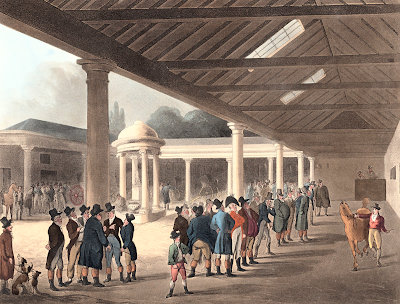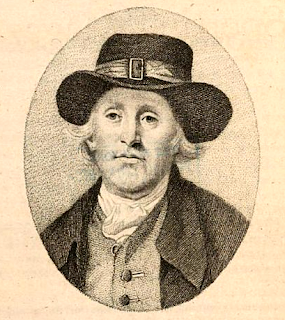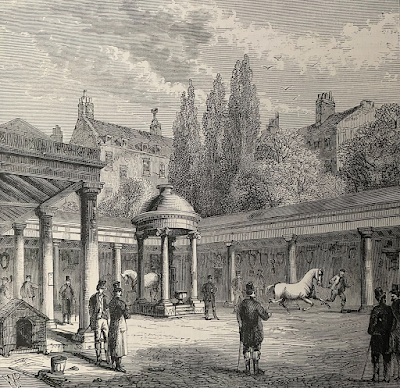 |
| Tattersall's Horse Repository by Rowlandson and Pugin (pub Ackermann 1809) |
Tattersall’s Repository was:
…the most fashionable resort of the sporting world for the purchase and sale of horses, hounds, carriages, &c.1
During the Regency period, when all road travel was horse-powered, there was a constant demand for horses, both to ride and to pull carriages. In addition, sportsmen needed hunters, and gentlemen of the turf bought and sold racehorses.
The best place to buy horses in Regency London was Tattersall’s Repository:
Where men of taste might enjoy the glimpses afforded of the most beautiful specimens of an exquisitely beautiful race, without being perpetually disgusted with the worst of all things—that of the jockey or horse-dealer.2
The founding of Tattersall’s Repository
 |
| Richard Tattersall, founder of Tattersall's from The Sporting Magazine (1795) |
In 1766 Richard purchased a 99-year lease of property near Hyde Park Corner from Lord Grosvenor and opened his business as a horse and hound auctioneer.4
The Sporting Magazine (1795) wrote:
Although there were occasional sales by auction, of horses, at the time when Mr Tattersall commenced his business, yet there was no regular repository, nor fixed sales at stated periods. This was an inconvenience felt by the public, and particularly by those who had studs of race-horses.
Mr Tattersall, who was well known to the gentlemen of the turf, and to the horse-dealers, offered his services as an auctioneer, and solicited their patronage. Lord Grosvenor warmly espoused him, and built for him those extensive and commodious premises at Hyde-park-corner.5
Old and New London (1878) pinpoints the location:
At the south-eastern corner of St George’s Hospital, where now is Grosvenor Crescent, was formerly the entrance to Tattersall’s celebrated auction-mart…The building itself, at the back, occupied part of the grounds of Lanesborough House.6
A family business
Tattersall’s Repository was a family business. Richard Tattersall—“Old Tatt”—took his son Edmund (1758–1810) into business with him, and in turn, Edmund took his son, another Richard (1785–1859), into partnership in 1806. It was this Richard who was running Tattersall’s during the Regency period.
What was Tattersall’s like?
 |
| The Entrance to Old Tattersall's from Old and New London Vol 5 by E Walford (1878) |
The entry was through an arched passage and down and incline “drive,” at the bottom of which was a public-house or “tap,” designated “The Turf,” for the accommodation of the throngs of grooms, jockeys, and poorer horse-dealers and horse-fanciers.
On the left, an open gateway led into a garden-like enclosure, with a single tree in the centre rising from the middle of a grass-plot, surrounded by a circular path of yellow sand or gravel.
Immediately beyond the gateway was the subscription-room; this building, though small, was admirably adapted for the purposes for which it was designed, and it contained merely as set of desks arranged in an octagonal form in the centre, where bets were recorded, and money paid over.
On the right of the passage, a covered gateway led into the court-yard, where the principal business of the place was carried on; this was surrounded on three sides by a covered way, and at the extremity of one side stood the auctioneer’s rostrum, overlooking the whole area.
The stables, where the horses to be sold were kept in the interim, were close at hand, and admirably arranged for light and ventilation. In the centre of the enclosure was a domed structure to an humble but important appendage—a pump.7
 |
| Interior of the Court-yard of Old Tattersall's from Old and New London Vol 5 by E Walford (1878) |
Sale by auction
Auctions were held on Mondays all year round, and on Thursdays as well, in the height of the season. In 1810, around 100 horses were sold each week, and Tattersall’s received a percentage commission on each sale.
- A good saddle-horse cost 40–100 guineas.
- A good pair of coach horses cost 150–400 guineas.
- A top hunter cost around 350 pounds.
- A racehorse cost about 1,500 pounds.
The premises were huge and could accommodate 120 horses. The sellers paid Tattersall’s a moderate fee for looking after their animals while awaiting sale, which was usually only a few days.
The horses to be sold in the main auction on Monday arrived on the previous Friday, and gentlemen could view the horses awaiting sale.
According to The Microcosm of London:
On the mornings when there is no sale, this Repository is a fashionable lounge for sporting gentlemen. The horses, &c. are then examined, their merits or defects considered, and sporting intelligence from all parts of the country detailed and disseminated.8
The Picture of London for 1818 is more specific:
Equestrians will be highly gratified every Sunday morning from twelve to two, at Tattersalls, where there is an exhibition of fine horses for sale, and often an assemblage of gentlemen of the first rank.9
Whole studs were sold at Tattersall’s, such as those of the Duke of Kingston (1774) and George, Prince of Wales (1786).
The Tattersall family developed their own stud. Old Tatt famously bought the unbeaten racehorse Highflyer for the incredible sum of £2,500 in 1779.
Though famous for selling horses, Tattersall’s also sold hounds and other dogs, and carriages and coach harnesses, by private contract.
 |
| A "Look in" at Tattersall's from Tom and Jerry: Life in London by E Pierce (1821) |
Old and New London described Tattersall’s as
…renowned through all the breadth and length of horse-loving, horse-breeding, horse-racing Europe.10
The Microcosm of London echoed this:
This Repository has ever possessed an acknowledged pre-eminence over every establishment of a similar character, and may be justly considered as of much public utility. It greatly facilitates the business of buying and selling horses, &c. and attracts both parties to meet each other in the market; while the liberal dealings of the late and present proprietors have entitled them to receive that patronage which they have so long experienced.11
But why was it so successful?
Tattersall’s was successful because it filled a gap in the market, connecting those who wanted to buy and sell horses through regular sales by auction. Old Tatt’s connections in London and Newmarket amongst the horseracing fraternity helped build Tattersall’s early reputation.
But according to The Sporting Magazine (1795), another factor that contributed to Old Tatt’s success in establishing the business was his willingness to give credit to his customers.
At other auctions the buyer generally pays a sum as a deposit when the lot is knocked down to him, and he is obliged to pay the remainder when it is taken away. But at Tattersall's, most men who were not of a very inferior order, or a disreputable class in life, took away the articles which they bought without making any deposit at the time of sale, and afterwards paid the purchase-money when it was convenient to them.12
It continued:
Gentlemen who sell, are often obliged to buy horses; with such he kept a running account, and served as a kind of banker to them. In some instances the balance was against him, but it was generally much in his favour. Those who had large studs to dispose of, found their account in enabling him to give credit. It increased the number of bidders, and always enhanced the price of the horses.13
 |
| Tattersalls - Tom and Bob looking out for a good one, among the deep ones from Real Life in London by E Pierce (1821) |
Tattersall’s was a fashionable venue for sporting gentlemen. A subscription room or betting room was set aside for the use of gentlemen of the turf, supported by a subscription of a guinea a year by its members. Here, bets were laid and settled.
Here the gentlemen of the turf assembled every sale day to lay wagers on the events of distant races, and here they met to pay and receive the money won and lost.14
The Sporting Magazine regularly reported the betting at Tattersall’s for the upcoming race meetings and boxing matches.
The Microcosm of London said:
Here the generality of bets which relate to the turf are settled, at whatever place they may originate; as it is not the custom, among these noblemen and gentlemen, to pay on the spot where the bets have been lost, but, on the return of the respective parties to town, at Tattersall's: so that this Repository is become a kind of exchange for gentlemen of the turf. Debts of this kind are settled here to an incredible amount.15
 |
| Monday after the 'Great St Leger' or Heroes of the Turf paying & receiving at Tattersalls by R Cruikshank from The English Spy by B Blackmantle (1825) |
Tattersall’s moved to a new location in Knightsbridge in 1865 when the 99-year lease on the Hyde Park corner site expired. It remained in the control of the Tattersall family until the 1940s, and is still one of the leading bloodstock auctioneers in Europe today.
If you have enjoyed this blog and want to encourage and help us to keep making our research freely available, please buy me a virtual cup of coffee by clicking the button below.
Notes
- The Sporting Magazine (1811).
- Walford, Edward, Old and New London: A narrative of its history, its people, and its places Volume 5 (1878).
- Sometimes the Duke of Kingston’s family name is written as Pierrepont.
- There are two dates I have come across for the foundation of Tattersall’s. 1766 is the date given on the Tattersall’s website for the founding of their firm, and this is supported by Vamplew’s article of the Tattersall family in the Oxford Dictionary of National Biography. It also ties in with the move to Knightsbridge after the 99-year lease expired. The Microcosm of London and some other sources set the date as 1773—the year Richard Tattersall’s employer, the Duke of Kingston, died.
- The Sporting Magazine (1795).
- Walford op cit.
- Ibid.
- Ackermann, Rudolph and Combe, William, The Microcosm of London or London in Miniature (1808-1810, reprinted 1904) Volume 3.
- Feltham, John, The Picture of London for 1818 (1818).
- Walford op cit.
- Ackermann op cit.
- The Sporting Magazine (1795).
- Ibid.
- Ibid.
- Ackermann op cit.
Sources used include:
Ackermann, Rudolph and Combe, William, The Microcosm of London or London in Miniature (1808-1810, reprinted 1904) Volume 3
Blackmantle, Bernard, The English Spy, illustrated by Robert Cruikshank (1825)
Egan, Pierce, Real Life in London or the rambles and adventures of Bob Tallyho, Esq, and his cousin, the Hon Tom Dashall, through the metropolis (1905 based on 1821 edition)
Egan, Pierce, Tom and Jerry: Life in London or the day and night scenes of Jerry Hawthorn Esq and his elegant friend Tom (First published 1821; 1869)
Feltham, John, The Picture of London for 1818 (1818)
The Sporting Magazine (various)
Vamplew, Wray, Tattersall family (c1765-1940) Oxford Dictionary of National Biography (Oxford University Press 2004)
Walford, Edward, Old and New London: A narrative of its history, its people, and its places Volume 5 (1878)

